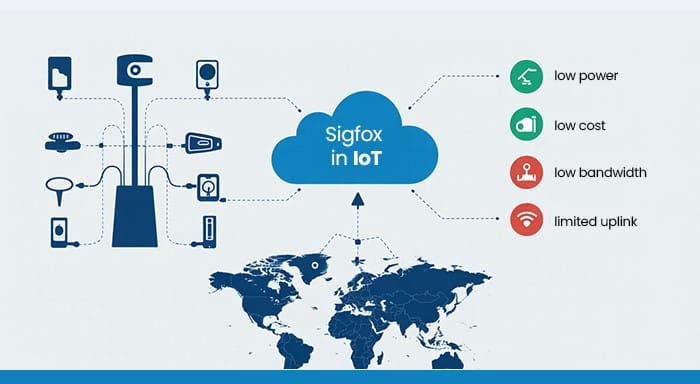The Internet of Things (IoT) is not just a tech trend—it significantly transforms a wide range of industries. These devices are designed to simplify our daily lives, saving time and boosting efficiency. Within the interconnected network, various communication protocols are used to communicate and exchange data across the IoT devices. Typically, these devices are operated on cloud-based systems, allowing devices to communicate within a long range wirelessly. Like other communications technologies, Wi-Fi, Zigbee, and LoRaWAN, Sigfox is renowned as a reliable, cost-effective, and low-power communication protocol.
With Sigfox in IoT devices, billions of devices connect efficiently with minimal amounts of power across a wide range of networks. This uses minimal base stations connected to the internet for data transmission using remote nodes across a larger area. It means that with this robust protocol, devices can run on a single battery for a long period of time, eliminating the need for repetitive maintenance and change. This guide will discuss the Sigfox protocol in IoT and how it transforms device communication. You will also learn what exactly Sigfox is, its features, benefits, and its significance in the IoT ecosystem.
Understand Sigfox in IoT
Sigfox is a reliable, cost-effective IoT protocol designed for long-range data transmission within Low Power Wide Aea Networks (LPWAN) technology. Typically, the protocol is used for devices that need to transmit small amounts of data over long distances while consuming minimal power. Unlike cellular networks that support large data transmission, Sigfox is like its lightweight alternatives, suitable for low-bandwidth IoT applications. Primarily, the protocol is used for M2M (machine-to-machine) in IoT applications which allow only small (usually 12 bytes) data exchanges per day. Its simplicity, low cost, and ease of configuration make it perfect for meters, trackers, and sensors in IoT that requires minimal power.
What Makes Sigfox Protocol Stand Out?
The Sigfox in IoT fundamentally transforms how we think about wireless connectivity. The technology is widely spread for its affordability, efficiency, and scalability compared to cellular networks that focus on speed and bandwidth. Whether you need a solution for large-scale applications like an asset monitoring system or water sensors across agricultural fields. This energy-efficient, high-rate IoT protocol has become a game changer for your IoT deployments. Let's discuss what sets Sigfox protocol in IoT apart from others:
Base Station
Base stations receive the message signals from IoT devices and then forward them to the Sigfox network for further processing. This includes a low-noise amplifier and spectrum monitoring, which keeps track of the spectrum of UNB (ultra-narrowband). These are the major components of the data transmission cycle.
Ultra-Narrowband
Sigfox in IoT leverages ultra-narrowband (UNB) technology to communicate and exchange information across wide area networks. With approx. 195 kHz bandwidth support, the connected network can manage multiple devices for broad range communication. This requires a small unit of radio spectrum to receive the data, allowing messages to travel far with less energy.
Streamlined Communication
The protocol is designed while keeping simplicity and ease of use in mind. Because of its star topology and cloud-driven architecture, it is easy to implement and manage. Sigfox technology supports both uplink (12 bytes) and downlink (8 bytes) communication for exchanging data among devices.
Ensured Security
Data transmission has a high likelihood of vulnerability and exploitation. To safeguard sensitive information, Sigfox implements security practices like authentication and encryption policies. The Sigfox protocol in IoT deployment utilizes 12-bit sequence number to prevent data and IoT devices from potential cyberattacks.
Real-World Applications: Sigfox in IoT Protocol
Sigfox is not merely a tech trend—it's serving a wide range of practical solutions across thousands of industries. Let us discuss some real-world applications of Sigfox.
- Smart Agriculture Using IoT: Many agriculture firms utilise soil moisture sensors powered by the Sigfox protocol in their fields to improve irrigation systems. With high durability, these sensors have life-long battery life, so there is no need to change it.
- Environment Monitoring Systems: The Sigfox in IoT is also used to monitor the environmental conditions such as humidity, air, temperature, etc. By enabling water and gas sensors, the systems can store, process, and transmit the data in remote locations.
- Asset Tracking System: E-commerce businesses use smart monitoring systems to keep track of the location and status of inventories during the shipping process. This system allows companies and customers to stay updated with the order status for the long term without any cost.
- Intelligent Utilities: Various smart applications like smart meters, waste management systems, and smart street lighting use the Sigfox protocol to monitor their performance. It establishes wireless connectivity with cloud systems that eliminates the need for wired connections.
- Industrial Applications: Its low power, wide-area connectivity make it capable of tracking sensor data across a wide range of industrial settings. With the sensors and actuators in IoT, it becomes easy to track and manage inventory in the supply chain.
Limitations of the Protocol
Let’s face it—no technology is perfect. As we discussed above, Sigfox in IoT is limited to small data rate and low energy required devices. But it is less effective when the IoT deployment requires high frequency, large data rates, and instantaneous messaging. Here is a detailed list to consider before implementing it:
- Data Rate Limitations: Sigfox only transmits small amounts of data, up to 12 bytes per day. It might not be suitable for expensive, media-rich applications that require high energy consumption.
- Latency: By prioritizing efficiency over speed, Sigfox has become a perfect communication protocol for small data transmission. However, it is not appropriate for frequent and real-time applications.
- Downlink Communication Limitations: While the Sigfox protocol in IoT supports bidirectional communication (both uplink and downlink), it has some limitations with downlink (network to device) communication.
Conclusions:
Sigfox is a well-known IoT protocol for its simplicity, low cost, and broad coverage for applications that require small, remote data transmission. This guide deals with the comprehensive understanding of Sigfox and its significance for a wide range of applications. The common goal of the Sigfox protocol in IoT is to establish a reliable network. It basically operates on a subscription-based model for network accessibility, unlike LPWAN technology. The scalability of Sigfox enables systems to grow with the increasing number of devices connected to the internet. With the billions of connected IoT devices, implementing Sigfox in IoT ecosystems is not just a choice—it plays a pivotal role.
Also Read
XMPP Protocol in IoT: Fundamentals
DDS Protocol in IoT: Features, Architecture, Working, and Applications


